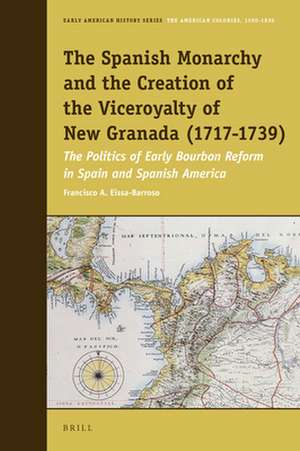The Spanish Monarchy and the Creation of the Viceroyalty of New Granada (1717-1739): The Politics of Early Bourbon Reform in Spain and Spanish America: Early American History Series, cartea 6
Autor Francisco A. Eissa-Barrosoen Limba Engleză Hardback – 12 oct 2016
Preț: 830.51 lei
Preț vechi: 1012.82 lei
-18% Nou
Puncte Express: 1246
Preț estimativ în valută:
158.91€ • 166.37$ • 131.49£
158.91€ • 166.37$ • 131.49£
Carte indisponibilă temporar
Doresc să fiu notificat când acest titlu va fi disponibil:
Se trimite...
Preluare comenzi: 021 569.72.76
Specificații
ISBN-13: 9789004308787
ISBN-10: 9004308784
Dimensiuni: 155 x 235 mm
Greutate: 0.61 kg
Editura: Brill
Colecția Brill
Seria Early American History Series
ISBN-10: 9004308784
Dimensiuni: 155 x 235 mm
Greutate: 0.61 kg
Editura: Brill
Colecția Brill
Seria Early American History Series
Cuprins
Chapter 1. The viceregal institution in the Spanish world under the Habsburgs
Chapter 2. Northern South America at the turn of the eighteenth century
Chapter 3. Reform under the first Bourbon: the dawn of the administrative monarchy
Chapter 4. Giulio Alberoni, reform through the vía reservada and the first creation of the viceroyalty of New Granada
Chapter 5. Two architects and faulty foundations? Explaining the suppression of the first viceroyalty of New Granada
Chapter 6. The viceroy’s subjects. New Granada under the first viceroyalty
Chapter 7. The end of reform? José Patiño and New Granada’s government between 1724 and 1739
Chapter 8. The Council of Indies and the War of Jenkins’ Ear: the second creation of the viceroyalty of New Granada
Chapter 2. Northern South America at the turn of the eighteenth century
Chapter 3. Reform under the first Bourbon: the dawn of the administrative monarchy
Chapter 4. Giulio Alberoni, reform through the vía reservada and the first creation of the viceroyalty of New Granada
Chapter 5. Two architects and faulty foundations? Explaining the suppression of the first viceroyalty of New Granada
Chapter 6. The viceroy’s subjects. New Granada under the first viceroyalty
Chapter 7. The end of reform? José Patiño and New Granada’s government between 1724 and 1739
Chapter 8. The Council of Indies and the War of Jenkins’ Ear: the second creation of the viceroyalty of New Granada
Notă biografică
Francisco A. Eissa-Barroso, Ph.D. (Warwick, 2010), is Lecturer in Latin American History at the University of Manchester. Among other publications, he co-edited Early Bourbon Spanish America: Politics and Society in a Forgotten Era (1700-1759) (Brill, 2013).
Recenzii
"Historians are at last examining in detail the relatively unknown initial half-century (1700–1750) of Bourbon rule in Spain's American realms. Eissa-Barroso (Latin American history, Univ. of Manchester, UK) adds to his earlier contributions on this topic a fine book that emphasizes the nature and politics of reform as the new dynasty shifted from the Habsburgs' traditional stress on providing justice to fostering an environment to promote economic well-being. Central to this change, the crown reduced the historic role of councils in advising the king and embraced a more vertical structure in which royal secretaries could act without this consultation. The monarchy also turned to experienced military officers as executives, curtailing the influence of men trained in law. The author uses the creation of the Viceroyalty of New Granada (today's Ecuador, Colombia, and Venezuela), its initial brief existence (1717–1723), and its reestablishment in 1739 as a case study of politics both at court and within the Viceroyalty. Based heavily on archival materials and recent secondary sources, this well-written book complements the opening chapters of Allan J. Kuethe and Kenneth J. Andrien's The Spanish Atlantic World in the Eighteenth Century (2014). Academic libraries should add Eissa-Barroso's volume to their collections."- M. A. Burkholder, University of Missouri, St. Louis
"For historians concerned with more marginalized social groups and individuals, this history highlights the odds against which other social actors participated in, and influenced, historical processes. This detailed work provides valuable insight into the functioning of a world empire and the historical influences that shaped the most obvious contours of that world." - Renée Soulodre-La France, King’s University College at Western University, in: Hispanic American Historical Review, Vol 98, issue 2 (2018), pp. 317-318 [doi: 10.1215/00182168-4379238]
"For historians concerned with more marginalized social groups and individuals, this history highlights the odds against which other social actors participated in, and influenced, historical processes. This detailed work provides valuable insight into the functioning of a world empire and the historical influences that shaped the most obvious contours of that world." - Renée Soulodre-La France, King’s University College at Western University, in: Hispanic American Historical Review, Vol 98, issue 2 (2018), pp. 317-318 [doi: 10.1215/00182168-4379238]











